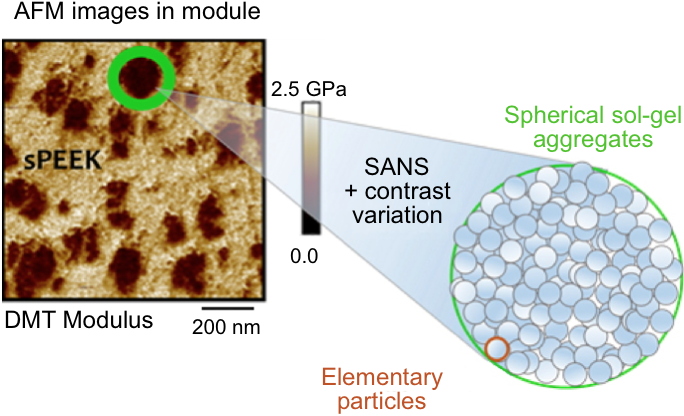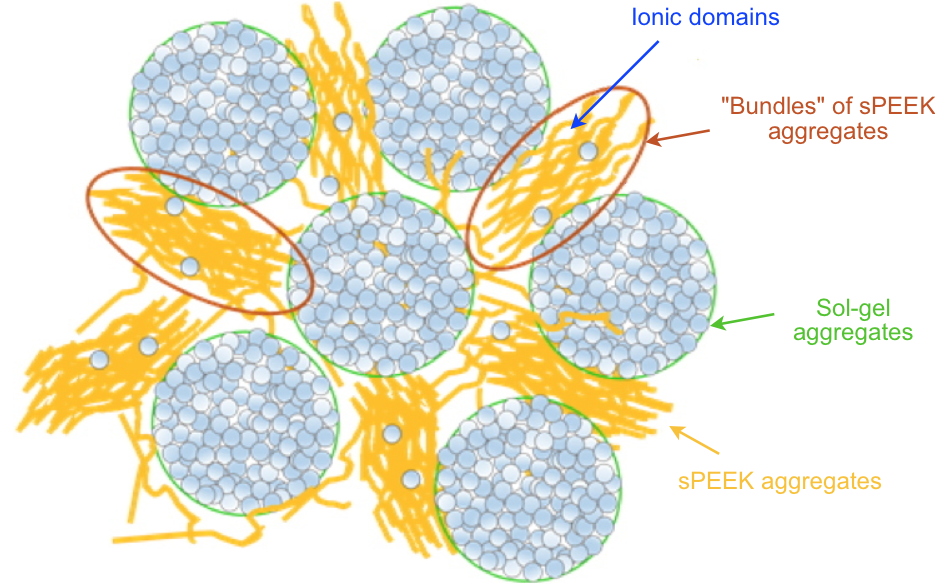The proton exchange membrane fuel cell, or PEMFC, converts chemical energy into electricity for the next generation of clean vehicles. Among the many attractive features of PEMFCs, manufacturers value high power density and fast start-up. This revolution requires the replacement of the current perfluorinated sulfonated membrane in the heart of the device (Nafion
® type), which no longer meets requirements: the challenge is to develop low cost membranes, associated to low environmental impact and high mechanical properties beyond 80-100°C. However, alternative membranes, such as
sPEEK, have two major drawbacks compared to perfluorinated membranes: their lifetime is shorter and their performances are lower. This issue is currently tackled by IRIG researchers with the objective to develop high performance membranes enabling the widespread implementation of PEMFCs.
sPEEK is an attractive polyaromatic membrane for high operating temperatures thanks to its excellent thermomechanical properties. However, it remains too sensitive to chemical oxidation during fuel cell operation. This sensitivity leads to a drastic degradation of its lifetime (a few hundred hours, compared to tens of thousands of hours for Nafion
®). It is therefore useless in its pristine form but a good candidate to quickly assess stabilization strategies. Thus, we have employed a strategy that has been little explored until now.
It consists in chemically stabilize the membranes by means of hybridization process. It has been applied successfully to sPEEK membranes [1]. A sol-gel phase was developed by self-condensation of
MPTMS within the sPEEK host membrane in order to protect it from oxidizing species generated during fuel cell operation. This is a sacrificial stabilizing process where the SH thiol groups, carried by the sol-gel phase, can be oxidized until the formation of SO
3H sulfonic acid groups. This disruptive strategy has allowed to design a new generation of hybrid membranes endowed with self-protective and self-improving
operando capabilities.
We explored the structure-properties interplay of these hybridized sPEEK membranes, as the morphology (size, interaction/dispersion, connectivity) and localization (polar/apolar regions) of the sol-gel phase inside the host membrane are parameters expected to be crucial for ionic conductivity, gas permeability, chemical stability and mechanical properties of the hybrid membranes
[2]. The nanostructure was explored at dimensional scales ranging from a few to a hundred of nanometers, using a combination of AFM/3D FIB-SEM (real space) and small angle neutron scattering (SANS)/wide angle X-ray scattering (WAXS) (reciprocal space) characterization techniques. The AFM modulus images showed that the sol-gel phase is distributed into large spherical domains whose size varies from 100 nm to 200 nm depending on the sol-gel content. Contrast variation SANS (Laue-Langevin Institute in Grenoble) allowed two important observations: on the one hand, the ion channels of the sPEEK are not obstructed (preserved ionic conduction) because they are only compressed by the insertion of the sol-gel phase; on the other hand, this phase has a hierarchical structure, like aggregates of elementary particles (
Figure 1). These observations show that the sol-gel nanoparticles grow in the so-called interbundle areas of the host sPEEK membrane (
Figure 2).
This multidisciplinary and multiscale experimental study addressed the question of the ideal distribution and localization of the sol-gel phase for an efficient chemical stabilization. The perspectives of this work consist in exploring the hybridization by a regenerative stabilizing sol-gel phase, a very promising strategy to increase the lifetime of the membranes.
 Figure 1. AFM modulus image of a hybrid membrane containing about 30% of sol-gel phase (top), a spherical sol-gel aggregate of spherical elementary particles.
Figure 1. AFM modulus image of a hybrid membrane containing about 30% of sol-gel phase (top), a spherical sol-gel aggregate of spherical elementary particles. Figure 2. Multiscale structural model of hybrid membranes.sPEEK
Figure 2. Multiscale structural model of hybrid membranes.sPEEK: sulfonated polyether ether ketone. A possible alternative to Nafion
® for proton exchange membrane fuel cells due to its many properties, including low cost and low gas permeability, availability, good proton conductivity, high thermal stability but poor chemical stability.
MPTMS: 3-(mercaptopropyl)trimethoxysilane.